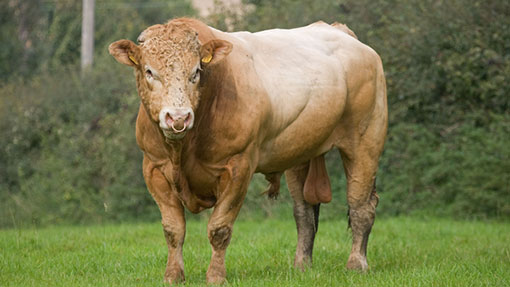Fit-for-purpose bulls should breed for six years

Farmers should be getting at least six breeding years from their bulls and aim to see them successfully serve 45 fertile, disease-free females in a nine week period.
Experts say these are the crucial targets to ensure farmers see a return on investment when buying a bull. However, the 2013 EBLEX bull survey highlights many bulls are not achieving this.
See also: Fertility testing stock bulls
Results show 35% of bulls bought in the past five years have been culled or died, with poor mobility being the main reason for culling.
Plus, one third of bulls failed to work for more than three years according to a sample from BCMS of 18,000 bulls born between 2000 and 2003.
Extending the breeding life and number of calves produced can lead to significant cost savings, shown in the table below. For example, production costs could fall from £48 to £30 a calf, if a bull producing 30 calves a year could be kept for an extra four years.
| Number of years used | Number of calves a bull a year | ||||
|---|---|---|---|---|---|
| 10 | 20 | 30 | 40 | 50 | |
| 1 | £330 | £165 | £110 | £83 | £66 |
| 3 | £143 | £72 | £48 | £36 | £29 |
| 5 | £106 | £53 | £35 | £27 | £21 |
| 7 | £90 | £45 | £30 | £23 | £18 |
| 9 | £81 | £41 | £27 | £20 | £16 |
Dylan Laws, EBLEX beef and sheep scientist, believes problems may begin before the bulls even arrive on the farm.
“Buyers at bull sales tend to be drawn to the bigger or heavier bulls and this encourages breeders to feed high levels of concentrates, for prolonged periods, to achieve high growth rates.
“However, such feeding strategies can increase the risks of skeletal problems, such as arthritis and haemorrhages in the hoof, leading to mobility issues. It can also reduce sperm volume and reserves, and increase the risk of sperm abnormalities,” he adds.
EBLEX advises farmers to maximise forage use and optimise concentrate use to achieve target growth rates. This reduces feed costs and helps ensure bulls are fit and fertile.
“A good target is not to exceed 40% concentrates in the total diet as dry matter,” says Mr Laws.
Bulls do not need to be overfed to achieve high estimated breeding values (EBVs). EBVs identify cattle with superior genes for growth, even when they are reared on high-forage diets and are lighter than those reared in more intensively-fed herds. Providing that there is enough genetic linkage between recording herds, EBVs will take these differences in herd management into account.
More information can be found in the new EBLEX Better Returns Programme publication Fit for Purpose Bulls.
